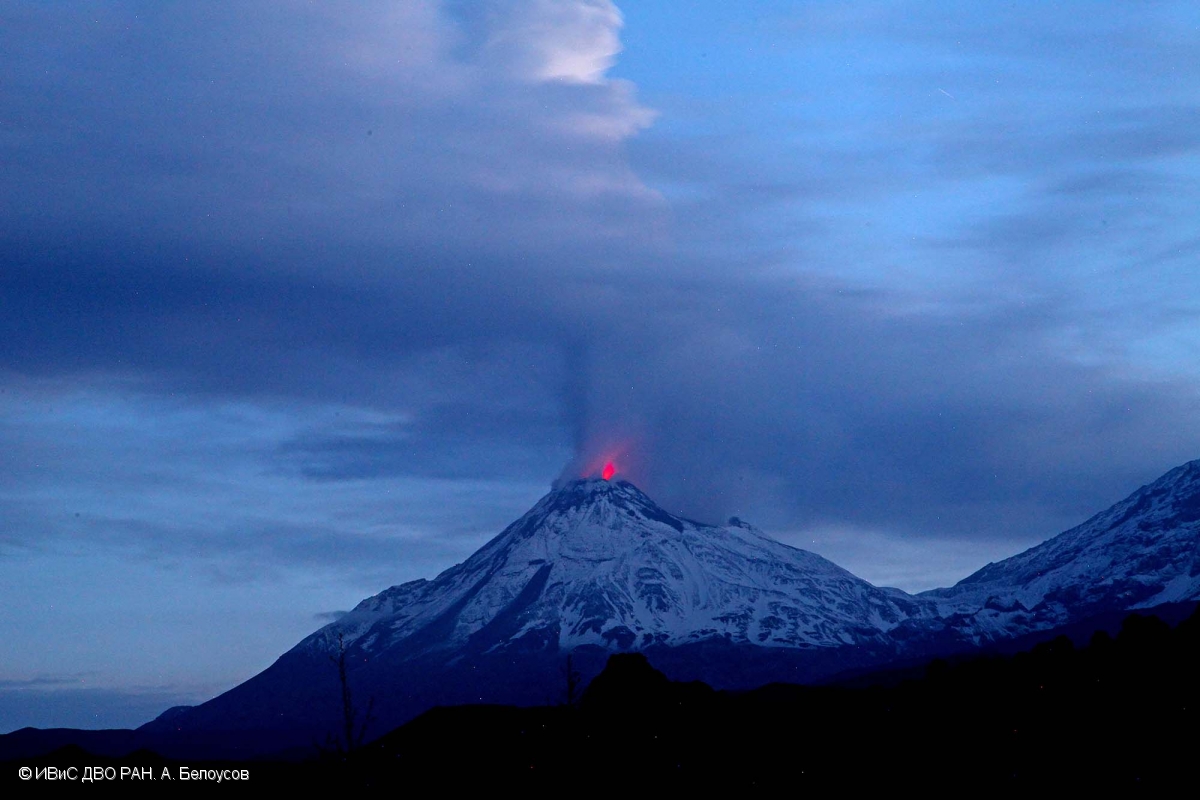Report on Bezymianny (Russia) — January 2018
Bulletin of the Global Volcanism Network, vol. 43, no. 1 (January 2018)
Managing Editor: Edward Venzke.
Research and preparation by Paul Berger.
Bezymianny (Russia) Eruption continues with ash plumes and lava flows through December 2017
Please cite this report as:
Global Volcanism Program, 2018. Report on Bezymianny (Russia) (Venzke, E., ed.). Bulletin of the Global Volcanism Network, 43:1. Smithsonian Institution. https://doi.org/10.5479/si.GVP.BGVN201801-300250
Bezymianny
Russia
55.972°N, 160.595°E; summit elev. 2882 m
All times are local (unless otherwise noted)
An eruption at Bezymianny continued into April 2017 with ash plumes and lava flows (BGVN 42:06). Similar activity was reported from May through December 2017. Observations came from reports from the Kamchatka Volcanic Eruptions Response Team (KVERT) and Tokyo Volcanic Ash Advisory Center (VAAC) advisories.
KVERT reported on 26 May that activity had decreased after an explosion on 9 March and the effusion of several lava flows onto the dome flanks. Though gas-and-steam emissions continued, along with thermal anomalies identified in satellite images. The Aviation Color Code (ACC) was lowered to Yellow (the second lowest level on a four-color scale). Moderate gas-and-steam emissions continued throughout the reporting period.
On 15 June KVERT reported that the temperature of a thermal anomaly identified in satellite images had increased, and that the webcam recorded a gas-and-steam plume rising to an altitude of 4 km and drifting SSE. Hot avalanches of material originated from the lava dome. The next day, 16 June, a powerful explosion began at 1653 (local) that produced an ash cloud that rose to an altitude as high as 12 km and drifted 700 km E and SE. Nighttime incandescence from the lava dome was observed afterwards, and a lava flow emerged from the W flank of the dome. The ACC was raised to Red (the highest level on a four-color scale), but lowered back to Orange (the second highest level) about 5 hours later. At 2110 (local) the ash cloud was 212 x 115 km in size and drifting E; the leading edge of the cloud was about 245 km E. Strong gas-and-steam emissions and incandescence above the lava dome could be seen on 18 June (figure 23).
 |
Figure 23. Photo of Bezymianny on 18 June 2017 showing the plume from a strong gas-and-steam emission, along with incandescence over the lava dome. Courtesy of A. Belousov, IVS FEB RAS. |
During 20 June-29 September a daily thermal anomaly over Bezymianny was identified by KVERT in satellite images, when not obscured by clouds. A lava flow continued down the W flank of the dome, and incandescence from the dome was usually visible at night. Moderate gas-and-steam activity continued.
According to KVERT, by the first week of October the volcano had quieted somewhat, although moderate gas-steam activity continued. KVERT reported that a lava flow continued down the W flank of the lava dome through 4 October, but no mention was made of a lava flow in their reports after 4 October. Weak daily thermal anomalies were recorded when the volcano was not obscured by clouds. On 5 October, the ACC was lowered to Yellow.
On 18 December hot avalanches on the SE flank of the lava dome were recorded by a webcam, prompting KVERT to raise the ACC to Orange. A strong explosion that started at 1555 (local) on 20 December generated ash plumes that rose to an altitude of 10-15 km, prompting KVERT to raise the ACC to Red. Ash plumes identified in satellite data drifted at least 320 km NE. Later that day satellite images indicated decreased activity; the ACC was lowered back to Orange. Moderate gas-and-steam emissions continued on 29 December, and a lava flow likely effused onto the N flank of the lava dome. Thermal anomalies continued to be identified in satellite images. The ACC was lowered to Yellow.
Thermal anomalies. During May-December 2017 thermal anomalies, based on MODIS satellite instruments analyzed using the MODVOLC algorithm, were only observed during a small portion of June and July 2017 (most days between 19-26 June, most days during the first week of July, 17-18 July, and 28 July). In contrast, the MIROVA (Middle InfraRed Observation of Volcanic Activity) system detected numerous hotspots every month, with the most intense cluster during the middle of June through the middle of September. Virtually all MIROVA hotspots were within 5 km of the summit.
Geological Summary. The modern Bezymianny, much smaller than its massive neighbors Kamen and Kliuchevskoi on the Kamchatka Peninsula, was formed about 4,700 years ago over a late-Pleistocene lava-dome complex and an edifice built about 11,000-7,000 years ago. Three periods of intensified activity have occurred during the past 3,000 years. The latest period, which was preceded by a 1,000-year quiescence, began with the dramatic 1955-56 eruption. This eruption, similar to that of St. Helens in 1980, produced a large open crater that was formed by collapse of the summit and an associated lateral blast. Subsequent episodic but ongoing lava-dome growth, accompanied by intermittent explosive activity and pyroclastic flows, has largely filled the 1956 crater.
Information Contacts: Kamchatka Volcanic Eruptions Response Team (KVERT), Far Eastern Branch, Russian Academy of Sciences, 9 Piip Blvd., Petropavlovsk-Kamchatsky, 683006, Russia (URL: http://www.kscnet.ru/ivs/kvert/); Institute of Volcanology and Seismology, Far Eastern Branch, Russian Academy of Sciences (IVS FEB RAS), 9 Piip Blvd., Petropavlovsk-Kamchatsky 683006, Russia (URL: http://www.kscnet.ru/ivs/eng/); Kamchatka Branch of the Geophysical Service, Russian Academy of Sciences (KB GS RAS) (URL: http://www.emsd.ru/); Tokyo Volcanic Ash Advisory Center (VAAC), 1-3-4 Otemachi, Chiyoda-ku, Tokyo, Japan (URL: http://ds.data.jma.go.jp/svd/vaac/data/); Hawai'i Institute of Geophysics and Planetology (HIGP) - MODVOLC Thermal Alerts System, School of Ocean and Earth Science and Technology (SOEST), Univ. of Hawai'i, 2525 Correa Road, Honolulu, HI 96822, USA (URL: http://modis.higp.hawaii.edu/); MIROVA (Middle InfraRed Observation of Volcanic Activity), a collaborative project between the Universities of Turin and Florence (Italy) supported by the Centre for Volcanic Risk of the Italian Civil Protection Department (URL: http://www.mirovaweb.it/).

